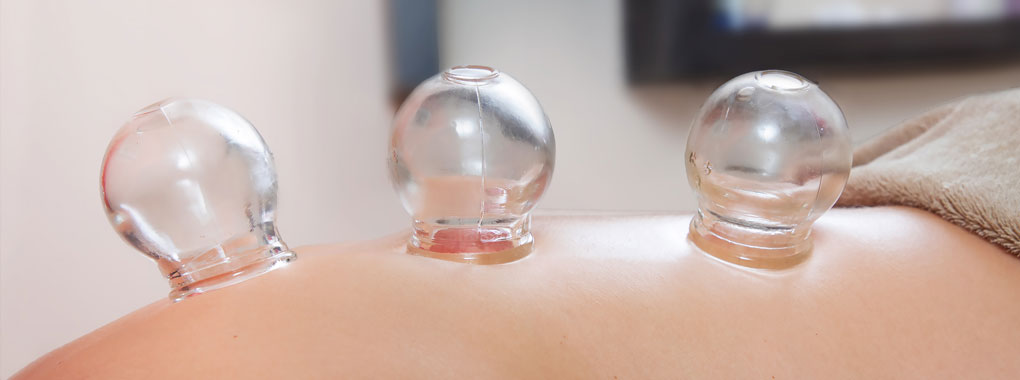Cupping is a technique used in Traditional Chinese Medicine that’s exploded in popularity in recent years. Many people remember seeing Michael Phelps with purple circles on his back and shoulders during the 2016 Summer Olympics, and since then scores of athletes (from professional to weekend warriors) have been “spotted” with the cupping marks.
I love adding cupping therapy to my patients’ treatments- in my experience it can really take someone’s results to another level. Most commonly, I use it for addressing pain anywhere on the back or neck, but it’s also great for hip, IT Band or shoulder pain. In some circumstances it’s also used for asthma, allergies or the common cold. You can have cupping either by itself or along with an acupuncture treatment.
What’s the theory behind cupping therapy?
Cupping involves the use of round glass or plastic cups. The glass ones are used for “fire cupping” (creating the suction using a flame briefly inserted in the cup which consumes all the oxygen, then placing the cup on your skin), and the plastic cups are used with a handheld pump which pulls the air out gradually. With fire cupping, the glass cups don’t become hot, and the flame never touches your skin.
Cupping is like a reverse massage– instead of pressure, cupping pulls the soft tissue upwards, creating a deep stretch and releasing tension and pressure on the underlying bony structures such as your spine. Like acupuncture, it also creates a temporary, low level of inflammation which signals to the body that repair is needed. It strongly moves blood and lymph to the area, activating the immune system.
The level of suction can really be adjusted based on the individual’s needs and preferences. In Chinese Medicine theory, it pulls “stuck” blood (which is causing pain, stiffness or poor circulation) to the surface of the body where it can be more easily eliminated. This is why the purple marks sometimes occur afterwards- the more tension and stagnation in an area, the darker the marks usually are.
Does it hurt?
It doesn’t hurt at all- in fact most of my patients report it feels really good (and I agree, from my personal experience)! As mentioned before, think of it like a reverse massage.
There are a few different techniques in cupping- the cups can either be left in place for up to 15 minutes, we can slide the cups around a large area of the body (sliding cupping) or the cups can be rapidly applied and removed (flash cupping). What’s best for your situation is something that your acupuncturist or other health professional will determine, and adjust based on your results and feedback.
How often can you get it?
I recommend getting cupping about once per week for most conditions- enough time for the healing process to complete itself and any marks to fade. For athletes, you can get cupping about once per week during your training cycle, or after big races to help facilitate recovery and decrease soreness. For patients with something like chronic tension and stiffness in their backs, usually I recommend once per week for 3-4 weeks. At that point normally you’re feeling much better so won’t need it as often.
My Favorite Uses for Cupping!
- Pregnant Patients- Because of the huge structural changes your body is undergoing, mid or lower back pain is really common. Pregnant patients respond beautifully to cupping, especially along the spine or around the hips.
- Athletes- as mentioned before, if Michael Phelps thought it helped him, it’s probably worth checking out! It’s helpful to stimulate more efficient recovery and decreased soreness during training as well as after races. I’ve performed cupping on swimmers, golfers, runners, Crossfit athletes and cyclists with good success.
- Tense and tight people- Oh, you’re sitting at your desk all day and have developed a tight upper back? This is normal, and cupping (and acupuncture) are really helpful for releasing those tired, overstrained muscles.
How long do the marks last? Are they always really purple?
The marks usually just last 48-72 hours (sometimes even less), but if they are darker, could last about a week. They do NOT always become very dark purple- they can be pink, red, light or dark purple. The color depends on many factors including the amount of suction used, the amount of tension in the tissues (more tension=darker marks), how long the cups are left on, and the overall goal of the treatment.
Please do consult with your acupuncturist if you’ve never had cupping before- it’s not right for everyone. If you have any type of skin condition or cut, if you have any bleeding disorders, or if you have particularly thin or delicate skin (as seed in the elderly) or have a severely compromised immune system, you probably shouldn’t have cupping. It also shouldn’t be performed over certain areas of the body. This isn’t by any means an exhaustive list of exclusions to cupping, so again I encourage you to consult with a trained professional to make sure it’s safe for you.
If you’re in the NYC area and are interested in trying cupping, please reach out! I offer 30 minute cupping sessions or if you’re already coming in for acupuncture, it can be integrated into your treatment as needed.

